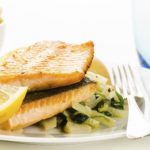Ten Surprising Nutrition Facts

The American diet circa 2007 is a disaster – but positive change has begun. Those were the twin themes of the “Fourth Annual Nutrition and Health Conference” held in San Diego, Calif., May 14-16, 2007. The conference was sponsored by the University of Arizona’s College of Medicine in conjunction with the Arizona Center for Integrative Medicine (AzCIM); AzCIM was founded and is co-directed by Dr. Weil.
The three-day event brought together leading nutrition researchers from around the world, bearing plenty of both bad and good news. Some highlights:
Bad News:
- Hunter-gatherers in the Australian outback today live on 800 varieties of plant foods. Modern Americans live principally on three: corn, soy and wheat.
From the presentation, “Phytonutrients: Nature’s Bonus from Plant Foods” by David Heber, M.D., Ph.D. Professor of Medicine and Public Health and Director, UCLA Center for Human Nutrition, David Geffen School of Medicine at UCLA
- One third of Americans get 47 percent of their calories from junk foods.
USDA” Trends in the United States – Consumer Attitudes and the Supermarket, 2000. From the presentation, “Phytonutrients: Nature’s Bonus from Plant Foods” by David Heber, M.D., Ph.D. Professor of Medicine and Public Health and Director, UCLA Center for Human Nutrition, David Geffen School of Medicine at UCLA
- The average American is eating 300 more calories each day than he or she did in 1985. Added sweeteners account for 23 percent of those additional calories; added fats, 24 percent.
Putnam et al. USDA. From the presentation, “Cultivating the Common Ground of Food, Nutrition and Ecological Health,” by David Wallinga, M.D., Director, Food & Health Program, Institute for Agriculture & Trade Policy, Minneapolis, Minn.
- Vitamin D deficiency is widespread. The following health problems have been linked to vitamin D deficiency: type 1 and 2 diabetes; multiple sclerosis; rheumatoid arthritis, osteoarthritis, periodontal disease, increased susceptibility to infection; osteoporosis, low birth weight infants; low seizure threshold; cancers of the breast, prostate, colon, pancreas and ovary; non-Hodgkin’s lymphoma; hypertension, myocardial infarction, stroke, congestive heart failure; wheezing in childhood, and compromised muscle strength and falls in the elderly.
From the presentation, “Vitamin D Deficiency: The Cause of Everything?” by Louise Gagne, M.D., Clinical Assistant Professor, Dept. of Community Health and Epidemiology, University of Saskatchewan, Saskatoon, Canada.
- In real dollars, the price of fresh fruits and vegetables has risen nearly 40 percent since 1985. In real dollars, the price of soft drinks has dropped 23 percent. The reason unhealthy foods tend to be less expensive on average than foods such as fresh fruits and vegetables has much to do with American farm policy.
Condensed from “Food without Thought: How U.S. Farm Policy Contributes to Obesity” Institute for Agriculture and Trade Policy, Environment and Agriculture Program, from the presentation, “The Omnivore’s Dilemma: Searching for the Perfect Meal in a Fast-Food World,” by Michael Pollan, Knight Professor of Journalism, University of California, Berkeley, Calif.
Hopeful News
- Ten cups per day of green tea delayed cancer onset 8.7 years in Japanese women and three years in Japanese men.
From the presentation, “Beef or Broccoli? Nutrition and Breast Cancer” by Victoria Maizes, M.D., Executive Director, Program in Integrative Medicine, Assoc. Professor, Clinical Medicine/Family & Community Medicine, the University of Arizona College of Medicine, Tucson, Ariz.
- Three meta-analyses of randomized, placebo-controlled trials found a 5-12 percent decrease in cholesterol levels in hyperlipidemic patients after at least 30 days’ treatment with 600-900 mg of garlic extract.
Warshafsky S., et al Ann Int Med 1993; 19;599-605; Silagy C, et al. JR Coll Phys Longdon 1994; 28:2-8; Ackermann RT, et al. Arch Intern Med 2001: 161: 813-24. From the presentation, “The Medicinal Spices” by Tieraona Low Dog, M.D., Education Director, Program in Internal Medicine, Assistant Professor, Dept. of Medicine, The University of Arizona, Tucson, Ariz.
- Maternal limitation of seafood consumption to less than 340 grams per week during pregnancy did not protect children from adverse outcomes. In contrast, this observational study [Avon Longitudinal Study of Parents and Children] showed beneficial effects on child development when maternal seafood consumption exceeded 340 grams per week, with no upper limit of benefit…
Hibbeln et al., The Lancet, 17 Feb., 2007. From the presentation of Joseph Hibbeln, M.D., Senior Clinical Investigator, Sectional of Nutritional Neurosciences, Laboratory of Membrane Biochemistry and Biophysics, National Institute on Alcohol Abuse and Alcoholism, Bethesda, Md.
- “I see a lot of hopeful trends, including the rise of alternative agriculture: organic, local, biodynamic…There are now over 4,000 farmers’ markets in the U.S. The number has doubled in 10 years.”
From the presentation, “The Omnivore’s Dilemma: Searching for the Perfect Meal in a Fast-Food World,” by Michael Pollan, Knight Professor of Journalism, University of California, Berkeley, Calif.
- Chocolate…may have a mild hypotensive [blood-pressure lowering] effect.
From the presentation, “The Medicinal Spices” by Tieraona Low Dog, M.D., Education Director, Arizona Center for Integrative Medicine, Assistant Professor, Dept. of Medicine, The University of Arizona, Tucson. Ariz.









